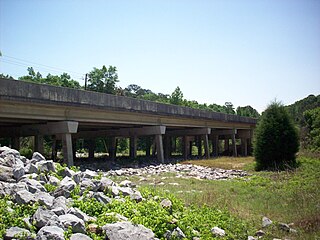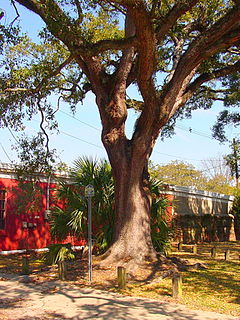
Courtland is a town in Lawrence County, Alabama, United States, and is included in the Decatur Metropolitan Area, as well as the Huntsville-Decatur Combined Statistical Area. The population was 609 at the 2010 census, down from 769 in 2000.

Cahaba, also spelled Cahawba, was the first permanent state capital of Alabama from 1820 to 1825, and the county seat of Dallas County, Alabama until 1866. Located at the confluence of the Alabama and Cahaba rivers, it suffered regular seasonal flooding.

Kathryn Tucker Windham was an American storyteller, author, photographer, folklorist, and journalist. She was born in Selma, Alabama, and grew up in nearby Thomasville.

Bride's Hill, known also as Sunnybrook, is a historic house near Wheeler, Alabama. It is significant as an example of a Tidewater-type cottage built on a large slave plantation. It was added to the Alabama Register of Landmarks and Heritage on April 16, 1985 and to the National Register of Historic Places on July 9, 1986.

The Pickens County Courthouse in the county seat of Carrollton, Alabama is the courthouse for Pickens County, Alabama. Built-in 1877-1878 as the third courthouse in the city, it is noted for a ghostly image that can be seen in one of its garret windows. This is claimed to be the face of freedman Henry Wells from 1878.

13 Alabama Ghosts and Jeffrey is a book first published in 1969 by folklorist Kathryn Tucker Windham and Margaret Gillis Figh. The book contains thirteen ghost stories from the U.S. state of Alabama. The book was the first in a series of seven Jeffrey books, most featuring ghost stories from a Southern state. Jeffrey in the book's title refers to a ghost that allegedly haunts Windham's home.

Kenworthy Hall, also known as the Carlisle-Martin House, Carlisle Hall and Edward Kenworthy Carlisle House, is a plantation house located on the north side of Alabama Highway 14, two miles west of the Marion courthouse square. It was built from 1858 to 1860 and is one of the best preserved examples of Richard Upjohn's distinctive asymmetrical Italian villa style. It is the only surviving residential example of Upjohn's Italian villa style that was especially designed to suit the Southern climate and the plantation lifestyle. It has a massive four-story tower, windows of variable size and shape with brownstone trim, and a distinctly Southern division of family and public spaces. The building was designed and constructed for Edward Kenworthy Carlisle as his primary family residence and the centerpiece of his 440-acre (1.8 km2) estate. It, along with some of its surrounding ancillary structures, was declared a National Historic Landmark in 2004. The house and a purported ghost are featured as a short story in Kathryn Tucker Windham's 13 Alabama Ghosts and Jeffrey.

The Goode–Hall House, also commonly known as Saunders Hall, is a historic plantation house in the Tennessee River Valley near Town Creek, Alabama. It was added to the National Register of Historic Places on October 1, 1974, due to its architectural significance.

William "Grancer" Harrison (1789–1860), aka The Dancing Ghost of Grancer Harrison, is the subject of several ghost stories about his alleged spirit seen dancing at his grave-site near Kinston, Alabama. The story was featured in the book 13 Alabama Ghosts and Jeffrey and is the subject of a song by country band Granville Automatic. Originally covered by a large wood-frame grave shelter, the tomb has been vandalized and rebuilt several times in the last 50 years, with the most recent vandalism at the cemetery in 2010. The tomb itself was last reconstructed in 2005.

William Sketoe, Sr. was a Methodist minister from the south Alabama town of Newton, whose lynching there on December 3, 1864 gave birth to one of Alabama's best-known ghost stories. While locally-told stories of his life usually say that he was hanged on trumped-up charges of desertion from the Confederate Army, other sources show that he was killed for allegedly aiding pro-Union renegades in the area. Whatever the reason for his murder, a shallow hole dug beneath Sketoe's feet during the hanging ultimately led to stories about "the hole that won't stay filled." According to witnesses, this hole never disappeared—even after being filled numerous times—retaining its original dimensions for the next 125 years.

Sturdivant Hall, also known as the Watts-Parkman-Gillman Home, is a historic Greek Revival mansion and house museum in Selma, Alabama, United States. Completed in 1856, it was designed by Thomas Helm Lee for Colonel Edward T. Watts. It was added to the National Register of Historic Places on January 18, 1973, due to its architectural significance. Edward Vason Jones, known for his architectural work on the interiors at the White House during the 1960s and 70s, called it one of the finest Greek Revival antebellum mansions in the Southeast.

The Chapel of the Cross is a historic Episcopal church in the Mannsdale area of Madison, Mississippi. The brick structure was built circa 1850–52. It is noted for its Gothic Revival architecture, which draws heavily from 14th-century English country churches. It was added to the National Register of Historic Places in 1972.
The Eliza Battle was a Tombigbee River steamboat that ran a route between Columbus, Mississippi and Mobile, Alabama in the United States during the 1850s. She was destroyed in a fire on the river near modern Pennington, Alabama on March 1, 1858. It was the greatest maritime disaster in Tombigbee River history, with an estimated thirty-three people killed, out of roughly sixty passengers and a crew of forty-five. The disaster and its aftermath saw the Eliza Battle enter southwestern Alabama folklore as a ghost ship, with numerous purported sightings of the burning ship from just north of Pennington to Nanafalia downriver. The story of the disaster and associated folklore has been fictionalized in several published short stories, most notably in “The Phantom Steamboat of the Tombigbee” in 13 Alabama Ghosts and Jeffrey.

The Dr. John R. Drish House, also known simply as the Drish House, is a historic plantation house in Tuscaloosa, Alabama, United States. It is considered by state preservationists to be one of the most distinctive mixes of the Greek Revival and Italianate styles in Alabama. First recorded by the Historic American Buildings Survey in 1934, it was added to the Alabama Register of Landmarks and Heritage on July 31, 1975, and subsequently to the state's "Places in Peril" listing in 2006. It was listed as Jemison School-Drish House on the National Register of Historic Places in 2015.

Belle Mina, known as Belmina during the 19th century, is a historic forced-labor farm and plantation house in Belle Mina, Alabama, United States. Completed in 1826, the Late Georgian-style house was built for Alabama's second governor, Thomas Bibb.

Annandale Plantation was a forced-labor cotton farm with an Italianate-style plantation house in what is now the Mannsdale neighborhood of Madison, Mississippi.

The Boyington Oak is a historic Southern live oak in Mobile, Alabama. In a city with many live oaks that are famous for their age and size, the Boyington Oak stands out as a singular example of one famous for the folklore surrounding its origin.

Colonel McNeal House, also referred to as McNeal Place or the Ezekiel Polk McNeal House, is an Italianate mansion in Bolivar, Tennessee, part of Hardeman County, Tennessee. The home was built for Major Ezekiel Polk McNeal's and his wife after their only child, a teenage daughter named Priscilla, died in 1854. Initial construction began circa 1858 and the mansion was completed during the American Civil War circa 1861 - 1862. It was designed by architect Samuel Sloan. In National Register of Historic Places filings it is described as "the finest Italianate house in West Tennessee and among the most outstanding in the state." The residence is a two-story brick building with square cupola. The home is located on Bills Street and Union Street. It is part of the Bills-McNeal Historic District.




















